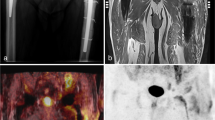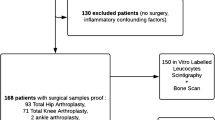Abstract.
Fluorine-18 fluorodeoxyglucose positron emission tomography (FDG-PET), technetium-99m hexamethylpropylene amine oxime (HMPAO)-labelled white blood cell (WBC) scintigraphy and bone scintigraphy were used in the evaluation of total knee arthroplasties (TKAs). We prospectively included 21 patients who had a three-phase bone scan for exclusion of infection of TKAs. Four hours after injection of 185 MBq 99mTc-HMPAO-labelled WBCs, planar and single-photon emission tomographic (SPET) imaging was performed. Planar imaging was repeated at 24 h p.i. Consecutively images of the knees were obtained with a dedicated PET system 60 min following the injection of 370 MBq of FDG. Focal tracer uptake was scored on SPET and PET visually (0=no uptake, 4=intense uptake). In addition, SUV (standardised uptake value) per voxel was calculated from attenuation-corrected PET images using the MLAA algorithm. Focal uptake at the bone-prosthesis interface was used as the criterion for infection before and after correlation with the third phase of the bone scan. Final diagnosis was based on operative findings, culture and clinical outcome. In the infected TKAs, the WBC scan showed focal activity of grade 2 (n=2), 3 (n=1) or 4 (n=2). PET scan revealed focal activity of grade 4 (n=5) or 3 (n=1). WBC scan alone had a specificity for infection of 53% [positive predictive value (PPV) 42%, sensitivity 100%], compared with 73% for PET scan (PPV 60%, sensitivity 100%). Considering only lesions at the bone-prosthesis interface that were also present on the third phase of the bone scan, we found a specificity of 93% (PPV 83%) for WBC scan. Using these criteria, a specificity of 80% (PPV 67%) was obtained for PET scan. Two out of three false-positive PET scans were due to loosening of the TKA. It is concluded that WBC scintigraphy in combination with bone scintigraphy has a high specificity in the detection of infected TKAs. FDG-PET seems to offer no additional benefit.
Similar content being viewed by others
Author information
Authors and Affiliations
Additional information
Received 17 April and in revised form 21 June 2001
Electronic Publication
Rights and permissions
About this article
Cite this article
Van Acker, F., Nuyts, J., Maes, A. et al. FDG-PET, 99mTc-HMPAO white blood cell SPET and bone scintigraphy in the evaluation of painful total knee arthroplasties. Eur J Nucl Med 28, 1496–1504 (2001). https://doi.org/10.1007/s002590100603
Issue Date:
DOI: https://doi.org/10.1007/s002590100603




